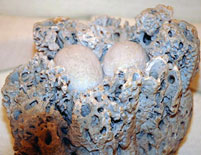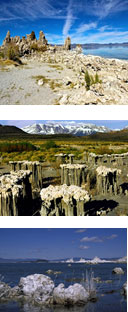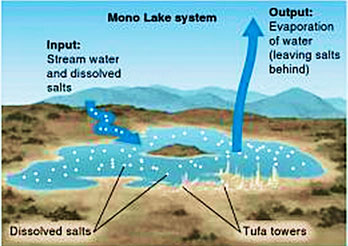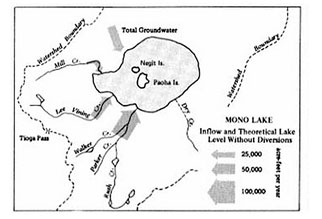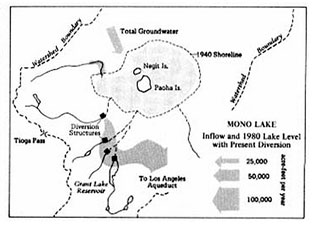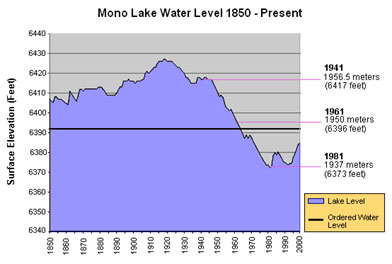Geology and Natural Heritage of the Long Valley Caldera
The Life of Tufa: An Examination of the Mono Lake Tufa Formations
M. Wolf
Abstract
Tufa can be found globally, with a large concentration in Greenland, and is speculated to exist on Mars. It is limestone (calcium carbonate) that forms from the mixing of calcium rich spring water and water with a high concentration of bicarbonate. It is frequently confused with travertine, a geothermal limestone precipitate. What makes tufa different than other forms of limestone is its arrangement and formation. The formation of tufa can create different formations: coatings, caves, towers and mounds. Mono Lake has come to be a terminal basin due to Basin and Range tectonic activity. Being a terminal basin means dissolved salts and sediments never leave, making Mono Lake an ideal salinity and alkalinity for tufa to form. The Mono tufa host millions of birds each year and provides protection for alkali flies. When the Los Angeles water diversion of 1941 began, the rapid exposure of previously submerged tufa damaged the ecosystem and tufa of Mono Lake. The detriments of a lower lake level incited preservation and restoration of the Mono Basin. The Mono Lake tufa has been studied to understand the lake’s past. Now that the Mono Lake tufa is protected by the state of California it can continue to grow and erode in a semi-natural manner.
The Life of Tufa – the Big Picture
1.1 Global Tufa
Tufa is a calcium carbonate precipitate found in freshwaters of high alkalinity around the world. Tufa deposits appear in Europe, Asia Minor, Africa, Australia, and are even theorized to exist on Mars [Ascione et al., 2014, Seuss, 1989, Perissinotto, 2001, Bornman et al., 2014, and Whiticar and Seuss, 1998]. The variety in size can be seen in comparing the kilometer spanning laminated lime muds of Croatia and the 200 kilometers of African coastline of active tufa stromatolite to the extremely localized sites of the Yorkshire waterfalls and the precipitates from the now-exposed, underwater volcano at Black Point in California [Bornman et al., 2014, and Ford and Pedley, 1996].
Figure 1. A bird’s nest fossilized in tufa Source: Cranbrook Institute of Science Collection, Bloomfield Michigan
1.2 Putting Together the Past
The importance of these global tufa deposits goes beyond their geological significance; their compositions can provide insights into historical chemical compositions and organisms. Bacteria, microphytes, macrophytes and invertebrates frequently have remains in tufa deposits. Ancient Roman buildings were constructed of tufa and travertine. Many buildings in Pompeii contain well-preserved specimens of organisms within their walls [Ford and Pedley, 1996]. Tufa deposits contain diverse specimens of organic matter. Ancient deposits in Denmark and Sweden contain birch remains and deposits in Switzerland contain hippopotamus, rhinoceros merckii, and elephas antiquus. These specimines have helped with inferring the prehistoric climate of the region in between ice ages [Wright, 1914]. The presence of tufa also helps with inferring past water quantities and compositions. William Bourke Wright explores this use of tufa in understanding the environment of the Quaternary ice age. With this strategy, Wright infers that the Bear River Lake in Utah, though it was an overflow at the time, was not entirely fresh. He comes to this inference due to the abundance of tufa on the remnants of Bear River Lake’s ancient shoreline [1914]. Eroded tufa helps with dating and inferring the past state of the environment [Madsen 2000]. Wright [1914] utilized the erosional pattern of tufa deposits in order to infer the pattern of water levels in Lake Lahontan. The primary deposits were weathered prior to the secondary deposits being deposited. This inference paired with the ancient clay lakebeds showing a primary weathered layer under a secondary top layer suggests that Lake Lahontan had two periods of high water levels separated by a period of dry recession, as seen from the primary tufa and clay weathering [Wright, 1914]. In his book, Travertine, Allan Pentecost [2005] addresses how cave travertine (which he later defines as including tufa as well) can help scientists infer the climate of the Quaternary age by comparing the ratios of stable oxygen isotopes to infer about the conditions when the site was deposited does this. Similarly, other molecules are frequently trapped and precipitate in deposits, which provide environmental and historical information of when the site was growing [Pentecost 2005]. Continuing with studies of the Quaternary age, a team of Italian geologists has begun linking tufa deposits with major Quaternary extensional faults. Their studies have connected tufa and springs of limestone aquifers to Quaternary age volcanism creating faults that lead to springs that ultimately form tufa (as well as travertine) [Ascione et al., 2014].
1.3 Tufa and Travertine
Similar to tufa is its commonly mistaken relative, travertine. There are varying definitions as to the exact differentiation between tufa and travertine, although it is generally accepted that travertine is a hot spring precipitate. In both Allan Pentecost and T.D. Ford and H.M. Pedley’s writings, they accept this level of differentiation. But from there it varies. In Allan Pentecost’s writings, he categorizes travertine as more dense and therefor less spongy than tufa [2005]. This definition places significance on the lithification of the material whereas T.D. Ford and H.M. Pedley write, "there are many crystalline and hard tufas, as well as friable travertines" so density cannot be used as a defining characteristic between the two [1996]. Ford and Pedley also mention the importance of the presence of, or lack there of, biological components. Due to the role of geothermal heating in creating travertine, it does not contain the frequent animal and macrophyte remains found in tufa (certain bacterial extremophiles can, however, be found in travertine deposits) [1996]. Further disagreement with defining these terms can be seen in recent publications as well. In 2011, Evelyn Mervine, a geologist with a degree in earth science and a PhD in marine geology disputes the common ground between Ford and Pedley and Pentecost. She notes that not all travertine forms at hot springs, some can precipitate from cooler waters. Even though she agrees with stating that tufa only comes from cooler water, Mervine still points out this commonly debated upon ground [2011]. Geological terminology is in a constant state of evolution. In the past and still in the present, the terms tufa and travertine have been used interchangeably. Yet, modern figures in geology constantly work to define terms, as seen through the slew of varying definitions between tufa and travertine.
1.4 Etymology
Part of the confusion as to the exact definition of ’tufa’ comes from the word’s origin. The word ’tufa’ has been used throughout history to describe a variety of materials. The term ’tufa’ originated in antiquity, stemming from the term tophus [Pentecost 2005]. Pliny used the term to refer to white or off-white deposits of semi consolidated material. This use of the term covered both calcareous tufa and volcanic tuff. In recent times the latter association with the term tufa has been dropped as the scientific community now refers to crumbly whitish pyroclastic material solely as volcanic tuff [Ford and Pedley 1996]. Because of all of these and more variation in accepted differentiation between tufa and travertine, an unequivocal definition has yet to be determined [Pentecost 2005].
Composition
1.5 Limestone
Tufa and travertine, along with all of the aforementioned global deposits of both, are all limestone. Limestone is made up of over 50% calcium carbonate by weight [sandatlas.org] The calcium carbonate (CaCO3) present in limestone is most frequently in the form of calcite but also as aragonite [geology.com and Bischoff et al. 1992]. What separates limestone from other types of rock containing calcium carbonate is that it is sedimentary. Because it is composition that makes limestone a limestone, it is the process of formation that defines different types of limestone [Pentecost, 2005]. Clastic limestone forms when marine organisms containing calcium carbonate shells and skeletons die and their detritus sinks to the marine floor. These materials then lithify when buried and subjected to enough pressure [sandatlas.org]. Evaporates are another product of limestone formation. Speleothems–stalactites, stalagmites, curtains and other underground formations of mineral deposits – are evaporates. When groundwater reaches cave ceilings, the water droplets may contain calcium carbonate that it absorbed as it soaked through the soil [Pentecost 2005]. When the droplets evaporate, the H2O goes into the air and the CaCO3 remains, leaving limestone. When this happens on cave ceilings, stalactites form, and on floors stalagmites. Limestone can also form from direct precipitation of calcium carbonate in marine or freshwater. This process forms chemical sedimentary rocks, including travertine and tufa [geology.com].
1.6 The Process of Tufa Formation
Tufa can form rapidly; in some instances they can grow an inch in a day [Collins and Leber, 2005]. The first step in tufa formation is the ingredients. It requires two sources of water with differing compositions; one must be rich in calcium and the other must be rich in carbonate. A chemical reaction takes place when the waters mix. The calcium and the carbonate combine by "react[ing] essentially in accordance with the solubility product of calcium carbonate in distilled water" [Dunn 1953]. Because the water solution becomes fully saturated, the calcium carbonate precipitates. This process can only occur underwater and usually happens around springs. The common set up for this to occur is having a highly alkaline body of water, loaded with carbonate, that has calcium rich freshwater feeding into it. This creates an ideal environment for tufa to form [Dunn, 1953, Pentecost 2005, and monolake.org].
In 20BC Strabo knew that certain springs would coat submerged objects in rock; he wrote of the petrifying waters in hot springs at Hierapolis, Turkey [Pentecost, 2005]. This account documented travertine, which is similar to tufa. Tufa can precipitate in this manner and many others. However, this sort of coating formation is one of the more common. The precipitation of calcium carbonate does not always occur by springs; calcium can drift through the water and precipitate far from its source. It can coat entire lakebeds and cover rocks, creatures, and any debris that fall into it [monolake.org]. Tufa also precipitates on shorelines of marine water. When tufa forms on steep slopes, it grows outwards for a bit and then begins growing down. This process creates tufa caves, common in costal areas where surface water degasses before mixing with the marine water [Lance and Mylroie, 2013]. When freshwater springs enter alkaline waters, tufa formations grow and build up at the entrance site. Possibly due to faults or fissure, some underwater springs that bring in freshwater are frequently close together and in a fairly linear pattern. This situation can produce one massive, elongated mound of tufa [Collins and Leber, 2005]. Not all underwater springs have clearly defined openings. Instead, many streams percolate through the sand and other sediments on the waterbed. The sand, being laden with brine and debris, often contains high concentrations of carbonates. Because of this, sand percolation is suitable for forming tufa [digital-desert.com/mono-lake/tufa]. In these instances, as the calcium rich spring water rises−as it is less dense than the high alkalinity water – it reacts with the sandy lake brine to form sand tufa [Collins and Leber, 2005]. It then barely precipitates on the lakebed, with most of it having formed underground [National Geographic]. In contrast, well-defined springheads allow freshwater to funnel close to straight up, rising still due to being less dense. The edges of the funnel begin to react and precipitate calcium carbonate. When this occurs on the top of the stream, the disruption creates irregularities in the formation. Currents can also cause irregularities. As this continues, the formation grows upwards, creating a tufa tower [Collins and Leber, 2005]. Tufa towers are more rare than other tufa formations; however, they do occur en mass in certain locations. Mono Lake is one of these sites [monolake.org].
Figure 2 From top to Bottom: Tufa towers, sand tufa and tufa mounds Sources: National Geographic (top two) and Marcel Holyoak
2 What makes Mono Lake Special
Mono Lake is home to fourteen ecological zones, approximately four hundred species of vertebrates and over one thousand plant species [kuriositas.com]. Spanning around 155 square kilometers in area, Mono Lake sites near the center of Mono Basin, which is 1800 square kilometers in area [Council and Bennett, 1993]. Mono Lake is one of the oldest lakes in the Americas, having formed at least 760,000 years ago [Hill, 2006]. It is the extremely reduced present-day Pleistocene Lake Russell. Because the lake has undergone hundreds of thousands of years of runoff, rock weathering and mineral precipitation, Mono Lake has higher mineral concentrations than most lakes [Council and Bennett, 1993]. Being a terminal basin has made Mono Lake the environment it is today. The inability for water to escape Mono Lake, aside from evaporating or entering the groundwater, makes it a sink for water [Dunn, 1953]. This means that all of the sediments brought to the lake remain in Mono and has resulted in approximately 280 million tons of dissolved solids within Mono Lake’s water [monolake.org]
2.1 The Importance of Plate Tectonics
The Mono Lake Region ultimately exists because of plate tectonics [Hill, 2006]. The Sierra Nevada and Basin and Range Province formed by normal faults. When the Pacific Plate subducted under the North American plate, the volcanic activity at the time dissipated and the underlying magma was left to slowly cool, crystallizing and forming new rocks that were forced upwards. The Sierra Nevada is a fault-block mountain range. A fault along its eastern side caused the eastern flank to uplift and the western dipped downwards on the western side [Tarbuck and Lutgens, 2000]. The Basin and Range Province formed because of horst and graben topography. As Earth’s plates separate, the tension causes the lithosphere to stretch, elongating and snapping at certain intervals. In the Basin and Range this process resulted in the formation of two hundred mountain ranges [Tarbuck and Lutgens, 2000 and Hill, 2006]. The Mono Basin exists because of the faulting that warps Earth’s crust [monolake.org]. Without plate tectonics, the Mono Basin would not be 3,353 meters below the Sierran Crest (measurement goes down to bedrock) allowing it to become a highly alkaline lake system as a terminal basin [Hill, 2006].
2.2 Interaction between surface water and groundwater systems
Because Mono Lake is a terminal basin, the water that feeds it is of upmost importance. The Sierra Nevadan rain shadow eliminates most of the direct rainfall on Mono Lake. Where the Sierran crest has an average of more than 45 inches of precipitation, Mono Lake’s eastern shore has an average precipitation of less than 5 inches [monolake.org]. The runoff that does not evaporate or absorb into the ground goes into Mono Lake. There are five streams that flow out of the Sierra Nevada and feed into Mono Lake [Warner and Hendrix, 1984]. The springs that come out of this western side of Mono Lake contain a Ca-HC03-type water with neutral to acidic pH. This water composition is more readily associated with recent tufa formation as opposed to the springs from the eastern shore. These eastern shore springs contain NaHC03-type water that comes from fine-grained rhyolitic ash; this composition is not associated with modern tufa deposits [Council and Bennett, 1993]. It is important to note the composition of tufa-depositing water in order to fully understand the environment of the Mono Lake region [Pentecost, 2005]. Other than these streams, there is speculated to be an aquifer in the western part of Mono Basin. This groundwater is thought to exist because many tufa mounds appear to be aligned along fault traces. With this evidence it is inferred that fracture conduits made a pathway for freshwater to enter Mono’s Lakebed and form the corresponding tufa [Council and Bennett, 1993]. This is supported by the characteristic of tufa deposits to be localized at sites of spring emergence [Pentecost, 2005]. The entirety of the water systems in the Mono Basin are related to one another; as the lake level rises and falls, so too does the level of springs and marshes surrounding it [National Research Council Staff, 1987]. This has to do greatly with Mono Lake being a hydrographically closed water body [Stine, 1990a]. It is also important to note that Mono Lake lies on a volcanically active location, home to the most recent volcanism in the Mono Basin [monolake.org]. It is speculated that the heating of groundwater causes the underwater springs to rise faster and significantly contributes to the formation of the famous tufa towers [Dunn, 1953]. The heating makes the freshwater rise in a near straight line due to its lower density in comparison to the surrounding waters [Hill, 2006].
Figure 3. Inputs and Outputs in the Mono Lake system Source: Environmental Science, Foundations and Applications
3 The Mono Lake Ecosystem and Tufa
Mono Lake houses extreme living conditions and appears at first not to be conducive to living things. Upon closer inspection however, the Mono Lake ecosystem is one of the most productive in the world [monolake.org]. Because of its unique water composition most organisms are unable to live in Mono Lake’s water. The extreme condition of Mono’s water allows halophiles and alkaliphiles to thrive [serc.carleton.edu]. The high alkalinity and salinity also provide ideal waters for brine shrimp and alkali flies which attract hundreds of species of migratory and nesting birds to the lake [monolake.org]. No fish naturally live in Mono Lake; the California Department of Fish and Game agency tried stocking the lake with trout, none of them survived [Hill, 2006]. The only time fish enter Mono Lake and survive is when creek fish dart in and out to catch brine shrimp [monolake.org].
A member of the family Artemiidae, Artemia is the only genus [Asem, 2008]. Artemia monica (common name: brine shrimp) are small aquatic crustaceans known for living in waters with extremely high salinities [Hill, 2006 and Asem, 2008]. The density of brine shrimp populations has a positive correlation with the bird density of Mono Lake. Though not all migratory and nesting birds at Mono Lake feed solely on brine shrimp, the larger masses of birds congregate where there are larger masses of brine shrimp per cubic meter [National research council, 1987].
3.1 Tufa’s Use for Birds
Mono Lake’s islands, Negit and Paoha, house the second largest California Gull nesting site in North America [monolake.org]. From April through July, Mono Lake is home to between 44,000 to 65,000 gulls that scratch out depressions in the rocky soil and nest among the shore’s tufa formations [monolake.org and Hill, 2006]. In the springtime, swallows seek out hollows in the tufa towers. Towers exposed in the middle of the lake have attracted Osprey since 1985. They build their nests on the tops of towers for the best vantage points and fly to nearby ponds and streams in order to feed [monolake.org]. The tufa of Mono Lake houses 80 species of migratory birds annually, providing them protection and shelter [Quinn and Vorster, 1998].
3.2 Tufa and Alkali Flies
Alkali flies play a huge role in the food web of Mono Lake, being the food of choice for hundreds of thousands of migratory birds [Hill, 2006]. Beyond their role in the ecosystem, alkali flies contribute to tufa formation. When alkali flies emerge from pupae, they leave behind trace amounts of calcium carbonate. This calcium carbonate contributes, however slightly, to tufa formation in Mono Lake [monolake.org]. Alkalie flies also rely on tufa in order to reproduce successfully en mass. The density of fly pupae and larva is significantly greater on hard or rocky substrates. For the Mono Lake flies, this means that they reproduce in greater numbers on and in tufa deposits compared to the mud or sand of the lakebed [Herbst and Bradley, 1993]. The harder substrate offers protection from currents and waves that would otherwise dislodge the pupae and larva, allowing birds to more readily consume them. The porosity of tufa allows the flies to better secure themselves than other hard materials. Tufa also has a greater density of food for the Alkali flies because the increased surface due to porosity allows for greater quantities of growth than loose sand or rock [Simeone, 2000].
4 Tufa and Humans
Tufa has long been an attraction to tourists and scientists alike. Many have come to Mono Lake in order to view the famous tufa formations with their own eyes. Before the European Americans arrived, an entire people, the Kutzadika’a, lived most of the year in the Mono Basin. Their entire tribe depended on the lake and its tufa formations for their survival [monolake.edu]. The tufa in Mono Lake houses one of the densest populations of Alkali flies in North America [Simeone, 2000]. The Kutzadika’a gathered the pupae of these flies in order to feed their tribe for half of the year. They lived peacefully in and out of the Basin, living off the lake [monolake.edu]. In 1852, when the first European Americans arrived, the lake and its people were living peacefully in harmony. It did not take long for this to change due to man’s new settlements. The influence of the immigrants on Mono Lake and native tufa has had a grossly negative impact on its unique environment [monolake.edu and blogs.ei.columbia.edu]. The tufa formations that attracted many early Americans and foreigners alike formed underwater and became exposed due to a natural decrease in the volume of Mono Lake [Stine, 1990a]. As the shorelines recede, tufa is exposed [Hill, 2006]. This process has been observed to happen naturally since the water level began being charted in the mid 19th century [Stine, 1991].
The 1940s proved to be a pivotal decade for Mono Lake. World War II began and the United States was placing all of its resources on the war. Around the same time, Los Angeles, California was growing. As its population rose, so did the demand for water [kuriositas.com]. In order to fulfill this new need, the Los Angeles Department of Water and Power started diverting water from Mono Lake’s feeder streams, sending their water 430 kilometers to the south [Stine, 1991]. This single decision brought havoc to Mono Lake.
4.1 Trouble After the Water Diversion
The first year after the diversions, a soapy film formed on the surface of Mono Lake [kuriositas.com]. The water level began dropping soon after. Tufa formations were exposed from the underside of the lake, making them subject to erosion at their bases (potentially toppling them) and subjecting them to vandalism and erosion from the new public access [National Research Council Staff, 1987]. The lowered lake level also exposed especially fragile sand tufa formations. As these deposits of tufa encrusted in sand spent more time out of water, the wind chipped away at the embedded sand, leaving behind thin tubes of tufa subject to easy breakage [National Geographic]. The water began to concentrate, increasing the concentration of dissolved salts [Bischoff et al., 1992]. By 1982 Mono Lake had dropped 45 feet vertically, raising its salinity towards the 97% it contains today [Stine, 1991 and Bischoff et al., 1992]. The scape of exposed lakebed became a danger to the locals. Local air pollution officials confirmed an increase in the frequency and size of dust storms. These storms violated air quality standards, as the dust was mixed with toxins, including arsenic, from the dried bed [Quinn and Vorster, 1998].
The lowered water level had a devastating impact on the residential wildlife. As the tufa towers eroded and fell, birds lost their nesting grounds [monolake.org]. Receding lake levels made the once protected islands peninsulas. This devastated the nesting havens, making them vulnerable to predators that could not previously reach the rookeries [kusiositas.com and monolake.org]. Mono Lake became so saline that the brine shrimp were in danger. Their population decreased 85-90% [Quinn and Vorster, 1998]. At too high salinity and alkalinity, the brine shrimp are unable to reproduce. Even though the lake still housed shrimp, this threat incited a petition to declare the brine shrimp endangered because an increased pH could be their end [Symonds, 1995]. The Alkali fly was also being threatened with death from this new landscape. Scientists mapped the most productive portions of the lake for Alkali fly reproduction by observing the density of larvae and pupae on soft and hard substrate. They found that the greatest abundance of fly nurseries is found at the 6380-foot lake surface elevation [Herbst and Bradley, 1993]. The lowering lake of 1982 went below this level, exposing the prime breeding grounds [monolake.org]. When the rock and tufa is exposed, the breeding ground is lost [Simeone, 2000]. This drastically cut the Alkali fly population. The lowered brine shrimp and Alkali fly densities affected the populations of nearly ninety migratory bird species that rely on the organisms as a primary food source [Heydinger, n.d.].
Figure 5. Distribution of Water Flow before and after water diversion Source: Warner and Hendrix, 1984
Figure 3. Mono Lake water level Source: monolake.org
4.2 Evidence of the Past
While Mono Lake seems fragile now, it has endured over 760,000 years of existence and is one of the oldest lakes in North America [Hill, 2006]. Once a massive Pleistocene water body, Mono Lake’s sheer age makes it an extremely desirable location for study [Scholl and Taft, 1964]. Scientists studying the old lakeshores and moraines in the Mono Basin concluded that Mono Lake’s water level was highest during the time of the largest glaciation [Hill, 2006]. Since then, Mono Lake’s water level has been fluctuating [Stine, 1990a]. As Mono’s water volume decreased, its salinity and alkalinity increased, ever trending towards the highly saline and alkaline waters of modern day Mono. The complexity of Mono’s brine reveals the old age of the lake as it is at the advanced state of being dominated by Na-CO and Zl-SO4 [Bischoff et al. 1992].
Mono’s tufa deposits are of special interest to study because they can provide insight to past climate and water composition. When the tufa forms, it traps other sediments and minerals useful for dating and studying [Dunn, 1953]. The towers also contain microorganisms, trapped by the rapid formation of towers, along with thin layers of algae [serc.carleton.edu]. The differing of mineral composition within ancient tufa can help with speculating the prehistoric temperatures during their formation because of the variety in solubility due to temperature [Council and Bennett, 1993]. Thin layers of tufa also coat old lakeshores. As rainwater flows down to Mono Lake, it traverses calcitic marble beds, likely dissolving and bringing with it some of the rock’s calcite. This is thought to be the origin of a large quantity of dissolved minerals in Mono Lake responsible for the formation of tufa. Once this rainwash entered the lake, it is likely to form tufa. The western shore is covered with formations with this speculated origin [Dunn, 1953].
5 The Future of Mono Tufa
The South Tufa grove’s tufa towers are estimated to be 200 to 900 years old. This grove represents recent growth in comparison to the glacial tufa deposits along ancient shoreline. Some reaching 13,000 years old [Pentecost 2005]. These groves show history but Mono Lake is still a living lake. The tufa in Mono continues to grow and is doing so at a rate of a few millimeters per year [Hill, 2006]. After the devastation from the 1941 Los Angeles water diversion, scientists, locals and the Mono Lake Committee fought for Mono Lake’s protection. After years of legal battles, the California State Water Resources Control Board issued to protect Mono Lake in 1994 and set a minimum acceptable lake level to which Los Angeles needed to restore Mono Lake [kuriositas.com and monolake.org].
The water diversion of 1941 has caused lasting damage. Even now that waters of Mono Lake are protected and its volume is being nursed back to healthy levels, the environment still has its scars. The exposed tufa towers are a constant reminder of LA’s brutish water diversion [Hill, 2006]. Because of this action, tufa structures are permanently damaged. The exposed formations are extremely fragile and prone to breaking. This makes restoring Mono Lake a simultaneously constructive and destructive path [Stine, 1991]. As the previously entirely diverted feeder streams are partially restored, Mono Lake’s water rises [Heydinger, n.d.]. The rising water decimates the delicate tufa structures along with the Mono and its islands’ shorelines. This damage breaks down formations and can topple towers; it not only destroys deposits cherished by visitors and protected by state and federal law, but it destroys nesting grounds for gulls and other birds [Stine, 1991].
The Tufa within Mono lake has played a large role in the environmental battle: first signaling a problem with their en masse exposure and then inspiring people to take up Mono Lake’s cause. The State and Federal governments now protect Mono Lake and its tufa, but the damage cannot be reversed. Mono Lake is now facing a new threat: drought. The drought caused Mono’s water level to drop three feet from 2011 to 2014 [Forgione, 2014]. Locals, environmental activists and the Mono Lake Committee are working to repair the crippled ecosystem in order to preserve it for future generations.
Works Cited
Anderson, A. 1988. Danger from Mono Lake Water Level. Nature 333. 109. Web.
Ascione, A., Iannace, A., Imbriale, P., Santangelo, N., and Santo, A. 2014. Tufa and travertines of southern Italy: deep-seated, faultrelated CO2 as the key control in precipitation. Terra Nova 26. 1: 1-13. Web.
Asem, A. 2008. Historical record on brine shrimp Artemia more than one thousand years ago from Urmia Lake, Iran. Journal of Biological Research-Thessaloniki 9. 113–114. PDF.
Bischoff, J.L., Stine, S., Rosenbauer, R.J., Fitzpatrick, J.A., and Stafford, T.W. 1993. Ikaite precipitation by mixing of shoreline springs and lake water, Mono Lake, California, USA. Geochimica et Cosmochimica Acta, 57. 16: 3855-3865. Web.
Bordenstein, S. 2015. serc.carleton.edu/microbelife. Science Education Research Center at Carlton College, n.d. Web.
Buchardt, I., and Stockmann, S. 2001. Ikaite Tufa Towers In Ikka Fjord, Southwest Greenland: Their Formation By Mixing Of Seawater And Alkaline Spring Water. Society for Sedimentary Geology 71. 1: 176-189. Web.
Buchardt, Seaman, Stockmann, Vous, Wilken, Düwel, Kristiansen, Jenner, Whiticar, M. Kristiansen, Petersen, Thorbjørn. 1997. Submariene coulmns of ikaite tufa. Nature 390. 129-130 (1997). Web.
Buderi, R. 1989. New Plan for Mono Lake. Nature 341. 478. Web.
Collins, R., and Leber, K. Life at the Limits: Earth, Mars and Beyond. Lunar and Planetary Institute. 2005. Web. 4 June 2015.
Council, T.C., and Bennett, P.C. 1993. Geochemistry of ikaite formation at Mono Lake, California: Implications for the origin of tufa mounds. Geology, 21. 11: 971-974.Web.
Dunn, J.R. 1953. The Origin of the Deposits of Tufa in Mono Lake. Journal of Sedimentary Petrology 23. 1: 18-23. Web.
Symonds, K. 1995. Endangered and Threatened Wildlife and Plants; 12-Month Finding for a Petition to List the Mono Lake Brine Shrimp as Endangered. Federal Register 60. 173(1995): 46571–46572. PDF.
Ford, T.D. and Pedley, H.M. 1996. A review of tufa and travertine deposits of the world. Earth-Science Reviews 41: 117-175. Web.
Forgione, M. California: More tufa towers exposed as Mono Lake water level drops. Los Angeles Times 18 July 2014. Web.
Funkhouser, D. Climate Change and the Future of Mono Lake. Blogs From the Earth Institute. Columbia University. Web. 3 June 2015.
Hart, J. Storm over Mono: The Mono Lake Battle and the California Water Future. Berkeley: University of California, 1996. Web.
Herbst, D.B. and Bradley, T.J. 1993. A population model for the alkali fly at Mono Lake: depth distribution and changing habitat availability. Hydrobiologia 267. 1-3: 191-201. Web.
Heydinger, T.A. The Mono Lake Controversy and the Evolution of California’s Public Trust Doctrine. University of California Davis Law, n.d. Web.
Hill, M. Geology of the Sierra Nevada. Rev. ed. Los Angeles: University of California Press, 2006. Print.
Lace, M.J. and Mylroie, J.F.. Coastal Karst Landforms. Springer Dordrecht Heidelberg: New York London, 2013. Web.
Limestone: What Is Limestone and How Is It Used? geology.com. Geoscience News and Information. n.d. Web. 7 June 2015.
Madsen, D.B. Late Quaternary Paleoecology in the Bonneville Basin. Utah Geological Survey, Utah Department of Natural Resources. 2000. Web.
Mervine, E. Geology Word of the Week: T is for Travertine. American Geophysical Union Blogsphere. American Geophysical Union. Web. 4 June 2015.
Mono Lake. Mono Lake Committee, Mono Lake Committee. n.d. Web. 3 June 2015.
National Research Council Staff. The Mono Basin Ecosystem: Effects of the Changing Lake Level. National Acadamies Press: Washington D.C., 1987. Web.
Pentecost, A. Travertine. Berlin: Springer, 2005. Web.
Perissinotto, R., Bornman, T.G., Steyn, P.-P., Miranda, N.A.F., Dorrington, R.A., Matcher, G.F., et al. 2014. Tufa stromatolite ecosystems on the South African south coast. S Afr J Sci. 110(9/10), Art. #2014-0011, 8 pages. Web.
Quinn, N. and Vorster, P. 1998. The role of science in resolution of environmental crises at Kesterson Reservoir and Mono Lake, California. Lakes and Reservoirs: Research and Management 3: 187-191. Web.
Sepp, S. Limestone Sandatlas. n.p. n.d. Web. 7 June 2015.
Simeone, M. The Biogeograpgy of Mono Lake alkali fly (Ephydra hians). San Francisco State University, Department of Geography. Geography 316: Biogeography. Fall 2000. Web.
Stine, S. 1990. Late holocene fluctuations of Mono Lake, eastern California. Palaeogeography, Palaeoclimatology, Palaeoecology 78. 3: 333-381. Web.
Stine, S. 1990. Past climate at Mono Lake. Nature 345. 391. Web.
Stine, S. 1991. Geomorphic, geographic, and hydrographic basis for resolving the Mono Lake controversy. Environmental Geology and Water Sciences 17. 2: 67-83. Web.
Stougaard, P., Jørgensen, F., Johnsen, M.G., Hansen, O.C. 2002. Microbial diversity in ikaite tufa columns: an alkaline, cold ecological niche in Greenland. Environmental Microbiology 4. 8: 487-483. Web.
Suess, E., Balzer, W., Hesse, K.-F., Muller, P.J., Ungerer, C.A., and Wefer, G. 1982. Calcium carbonate hexahydrate from organic rich sediments of the Antarctic shelf: precursors of glendonites. Science 216: 1128–1131.
Tarbuck, E. and Lutgens, F. Earth Science. 9th ed. Prentice Hall, 2000. PDF.
The Tufa Towers of Mono Lake. Kuriositas. n.p. 14 December 2010. Web. 6 June 2015.
Warner, R.E., and Hendrix, K.M. California Riparian Systems: Ecology, Conservation, and Productive Management. Berkeley: University of California Press, 1984.
Whiticar, M. and Suess, E. 1998. The Cold Carbonate Connection Between Mono Lake, California and the Bransfield Strait, Antarctica. Aquatic Geochemistry 4: 429-454. Web.
Wright, W.B. The Quaternary Ice Age. Macmillan and Co.: London, 1914. Web.
[Return to Research Projects] [Return to Sierra Home]
